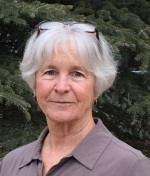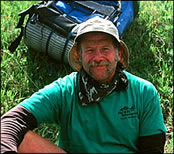You are currently browsing the tag archive for the ‘Stewart Brandborg’ tag.
Can We Still Keep Wilderness Wild?
by Louise Lasley
 Most of us probably believe we can correctly figure out fact from fiction, good from bad, and many other distinctions we make every day. But sometimes our perceptions are forged by subtle, if inadvertent, messages we receive. And before long the collective perspective becomes our culture with an almost unobservable change in what is believed to be right or good or necessary. This shift from original intent to accepted practices applies to our best-protected lands and threatens not only designated Wilderness, but the Wilderness Act, too.
Most of us probably believe we can correctly figure out fact from fiction, good from bad, and many other distinctions we make every day. But sometimes our perceptions are forged by subtle, if inadvertent, messages we receive. And before long the collective perspective becomes our culture with an almost unobservable change in what is believed to be right or good or necessary. This shift from original intent to accepted practices applies to our best-protected lands and threatens not only designated Wilderness, but the Wilderness Act, too.
I recently received information on an upcoming wilderness festival, and the first thing that caught my attention was the phrase: “management is a necessary part of our interaction with this resource” (meaning Wilderness). I count this as one of those subtle messages that tend to shift behavior. To manage something is a dynamic, manipulative action that implies human intervention and control. The responsibility of the four federal agencies that oversee Wilderness is to administer these lands using a hands-off approach rather than manage them. Congress and the American people have set aside Wilderness to allow nature to call the shots.
The Wilderness Act defines Wilderness as, “…an area where the earth and its community of life are untrammeled by man, where man himself is a visitor who does not remain.” Howard Zahniser explained in a 1957 speech the intended meaning of “untrammeled” as “free, unbound, unhampered, unchecked, having the freedom of the wilderness.”
Stewart Brandborg worked closely with Zahniser on the Wilderness Act, and then served as executive director of the Wilderness Society for 12 years after the law’s 1964 passage. These two roles created millions of acres of designated Wilderness. The late Bill Worf, a former Forest Service (FS) supervisor and fierce advocate for Wilderness, was part of a small group tasked with writing the FS regulations for the Wilderness Act. For years these two men were the backbone of Wilderness Watch, the only national organization working exclusively to assure that Wilderness is administered according to the law. Neither would stray from their conviction that the Act does not allow for compromise nor should it be subject to individual interpretation.
I can’t tell you when the shift from the original intent for stewardship of these lands began, but it has been moving a lot. The other night at dinner Stewart Brandborg said that the next presentation regarding Wilderness should be titled: “It’s all Screwed Up.” Here are a few examples of how the law is being disregarded:
- A private company used a helicopter to haul materials to repair the Fred Burr High Lake dam in the Montana portion of the Selway-Bitterroot Wilderness, even though in the past materials were carried in by packstock or found onsite.
- A proposed road would cut through the Izembek Wilderness in Alaska.
- In the Boundary Waters Canoe Area Wilderness in Minnesota, commercial towboat traffic has increased significantly instead of maintaining levels existing at the time of designation.
- There is a proposal to considerably expand the Fish Lake airstrip in the Selway-Bitterroot Wilderness in Idaho.
- In the Emigrant Wilderness in California, buildings have been rebuilt and commercial packstations exceed historical numbers.
- Commercial shellfishing is occurring in the Monomoy Wilderness in Massachusetts.
- 450 Helicopter landings have been proposed for bighorn management in Wildernesses in Arizona.
- Motorized cattle herding has been proposed in Wildernesses in the Owyhee region of Idaho.
- Water developments have been built in the Kofa Wilderness in Arizona, using construction equipment and helicopters.
- Unnecessary structures have been restored and rebuilt in the Olympic Wilderness in Washington.
- And on and on…
Such illegal actions were probably considered acceptable by the agencies, weren’t that much different than some earlier action, or would help with an issue unrelated to Wilderness. Or as my friend Howie says, “They have landscape amnesia.” In other words, they’ve forgotten what Wilderness is supposed to be. All illegal actions are damaging to Wilderness, but cumulatively they amount to a “death by a thousand cuts,” with incremental changes sometimes only obvious over longer periods of time.
How did we get to this place? Who is responsible? Often, agency employees notify Wilderness Watch of violations occurring in Wilderness. The most abused part of the Wilderness Act is the administrative exception in section 4(c), which allows the minimal action necessary to administer the Act. It was intended to apply to those exceedingly rare instances where motorized equipment, motor vehicles, aircraft, structures or installations are truly necessary and constitute the absolute minimum required to preserve Wilderness. Instead, the agencies increasingly invoke the exception whenever it is convenient or to promote recreation or one of the other uses of Wilderness. Unfortunately, many of these violations provide the jumping-off step for the next, bigger illegal action.
The U.S. Forest Service, the National Park Service, the Bureau of Land Management and the U.S. Fish and Wildlife Service have a long history of resisting the Wilderness Act. But it is not just the agencies that have dropped the ball. Congress has failed in its oversight of the agencies and its review of the state of the Wilderness system. A 1989 Government Accounting Office (GAO) report requested by the House Subcommittee on National Parks and Public Lands found that the Forest Service was “devoting only minimal attention to wilderness,” but nothing came of the report’s recommendations to prevent further degradation of Wilderness. In 1995, Congress passed the Paperwork Reduction Act, which rescinded a provision of the Wilderness Act that required the agencies to submit substantive annual reports to Congress on the state of the Wilderness system. And in perhaps the most alarming assessment of the Wilderness system, a 2001 report by the Pinchot Institute for Conservation warned, “The four wilderness agencies and their leaders must make a strong commitment to wilderness stewardship before the Wilderness System is lost.” Yet neither Congress nor the agencies have made any meaningful actions to address the recommendations of this in-depth, comprehensive report. It is now largely forgotten.
Current stewardship oversight, or lack thereof, is only part of the degradation of Wilderness by Congress. Congress is proposing bills as damaging to Wilderness as the violations the agencies are carrying out—and maybe more so. Bills designating Wilderness in the past were clear and simple and adhered to the Act. Increasingly, wilderness bills include exceptions not in the Act, have language that undercuts the Act, or add damaging non-conformities to both existing and proposed Wildernesses. The current Congress includes 51 such bills. , Many of the proposed bills are supported by the larger conservation organizations, who, because of their size, proximity to DC, and their budgets, have usurped negotiations from local organizations who are working to designate additional Wilderness. These larger organizations who claim that compromise is necessary to gain more public support, along with Congress, are making the Wilderness Act into something other than what was envisioned during its long and inclusive passage into law.
So whose responsibility is it to ensure that Wilderness retains the character that makes it wild, that ours and future generations are able to experience the wild, and that accountability for wilderness is acknowledged and accepted? I believe this responsibility belongs to Congress, to the four administering agencies, and finally to us—the “public”, the folks who know the wilderness lands around them, cherish their unique and special qualities, and are grateful for what Wildernesses don’t have: those activities that would make a Wilderness just the same as any other place. The question remains, can we still keep Wilderness wild in the face of so many challenges to the Act’s original intent?
Louise Lasley’s (president of Wilderness Watch) pursuit of backcountry activities produced a strong advocacy for wilderness and the values we find in wild places. She has worked for years to protect those values around the globe and particularly within the Greater Yellowstone Ecosystem. Work on public lands and wildlife issues for the Jackson Hole Conservation Alliance, Northern Rockies Conservation Cooperative, the Wildlife Conservation Society, Africa Rainforest and River Conservation, and as a naturalist for the Bridger-Teton National Forest and Spring Creek Resort has been fundamental to her new endeavor to look at local issues as she travels around the West. After living in Jackson Hole for 30 years, Louise began the life of a gypsy this year looking for a someplace to call home. She hopes that her knowledge and experience of public lands and wildlife concerns will help in her transition to a new community.


You must be logged in to post a comment.